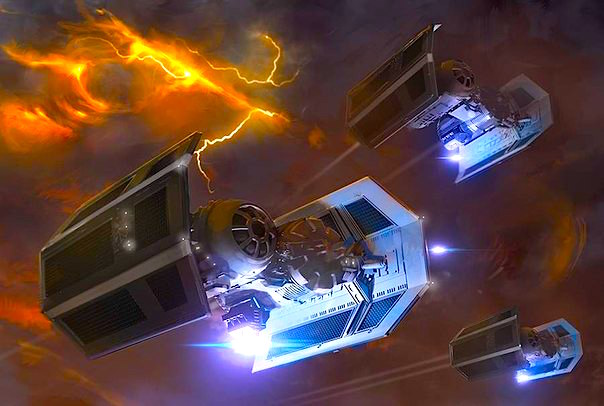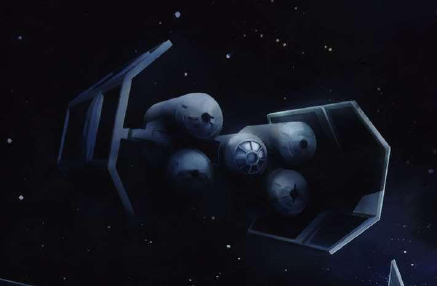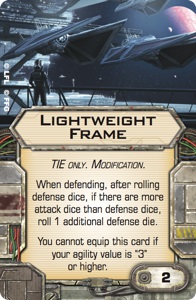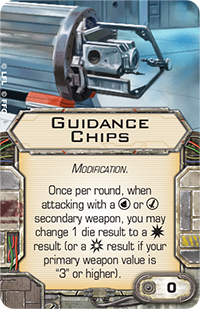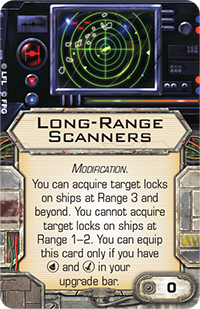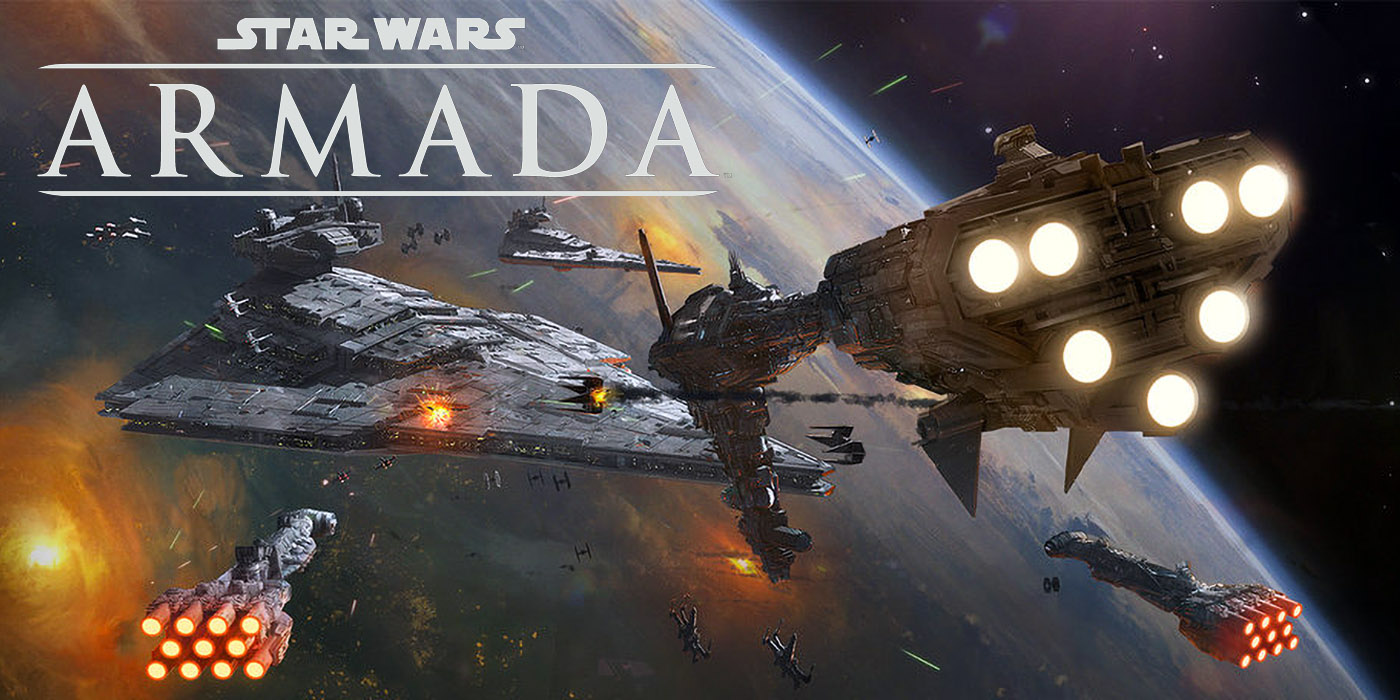X-Wing: TIE Bomber Mod Blues
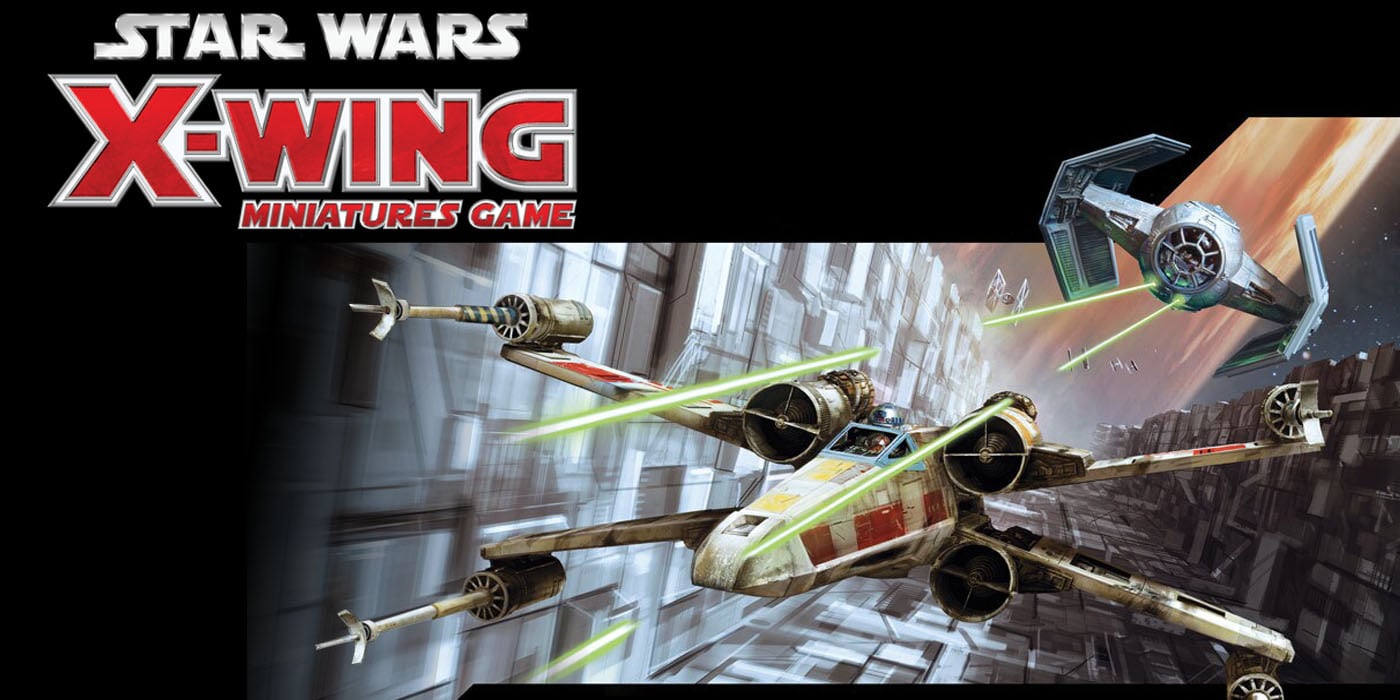
TIE Bombers and Punishers need all the help they can get. What modifications serve them best?
A question was posed to me recently: when should TIE Bombers and Punishers take Guidance Chips, and when should they take Lightweight Frame?
This is a delicious sort of problem because it’s multi-dimensional. Your choice of modification is dependent on both flying- and math-based factors, and the math changes depending upon your situation. Let’s dive right in!
Lightweight Frame
Adding a point of agility is pretty valuable– Stealth Device adds a point of agility and costs three points and goes away when struck, so at first blush Lightweight Frame seems like a steal in comparison.
The tricky thing is that extra agility is at its best when you’ve got tokens to further enhance it. (Paging Soontir Fel, please pick up the white courtesy phone.) TIE Bombers and Punishers, who are spending their actions on target locks or bomb drops, don’t have that luxury. Compounding this complexity, agility (compared to, say, an evade token) is more or less effective depending upon what kind of attacks you’re taking. Put another way: extra agility is more powerful against a higher number of weaker attacks, and less effective against a smaller number of stronger attacks.
(This logic also applies to why people used to fly R2-F2 with Biggs, but these days prefer R4-D6. The meta shifted away from low-attack swarms and towards high-attack obliteration.)
To illustrate, let’s look at TIE Bombers and Punishers against generic 3-dice focused attacks like most ships can make, and against a Jumpmaster’s focused-Chipped Plasma Torps.
Punisher math:
- vs 3dice w/ focus: 4.8 shots to kill
- LWF vs 3dice focus: 6 shots to kill
- vs Jump: 2.5 shots to kill
- LWF vs Jump: 2.8 shots to kill
Against three dice, you’re making a considerable difference– you’ll usually take another shot or even two before you fold. Against the torps it’s not quite as impressive, as it’s going to be three torps either way. However, there is still a difference from your opponent’s perspective: if you have 1-2 hull left and one agility, he might try to finish you off with just a primary attack; if you have 2-3 left behind two agility, he’s probably going to spend another torpedo.
Things are a little different for the Bomber. You’d think that adding an extra point of agility on to the two it has would make a big difference. Instead, the fact that the agility is protecting less health is the bigger factor:
Bomber math:
- vs 3dice w/ focus: 4 shots to kill, 3% chance of a two-shot
- LWF vs 3dice focus: 5.3 shots to kill, 1% chance of a two-shot
- vs Jump: 1.8 shots to kill, 45% chance of a two-shot
- LWF vs Jump: 2.1 shots to kill, 30% chance of a two-shot
Against three-dice attacks, this is a notable difference in survivability. Against high-accuracy torpedoes, not so much; you’re really just changing your chances of getting two-shot. To put it in more practical terms: in a six-game tournament, your TIE Bomber will get two-shot by torps in three games; with Lightweight Frame, it’s down to two games. That’s not nothing, but it’s also not terrific.
Note that the TIE Bomber gets *no* survivability benefit against 2-red attacks, like from other TIEs, except at range 1; if those are common ships in your area, Lightweight Frame is not for you.
This meta-dependence is a big part of Lightweight Frame: there are certain enemies it helps against, and others it does not, making it a bit of a gamble for its two point cost. Two points probably won’t break the bank, but it is noticeable, especially in comparison with…
Guidance Chips
Unlike Lightweight Frame, Guidance Chips are relatively meta-independent and are valuable always, for zero points. Just how good are Guidance Chips? On a standard four-dice throw, you’ll have some result other than 4 hits 93% of the time– meaning that 93% of the time Chips are worth an extra hit.
The math gets more complicated when you start talking about ordnance with inherent accuracy adjustments– ProTorps, for example. However, even though Guidance Chips is less likely to trigger with accurate ordnance, it still makes a huge impact. That’s because each hit result you add to an attack is more powerful than the one before it.
Consider a Homing Missile Shot:
(Because it makes the math easy on me) If you’re shooting against, oh, I don’t know, a two-agility unfocused target (*coughs*), Guidance Chips will only kick in 68% of the time– much less frequently than our unfocused Plasma Torps case. However, adding Chips *more than doubles* the odds of getting 4 hits on the shot, which in turn more than doubles the odds of dealing 4 damage. Specifically:
- Without Chips: 0 damage = 6%, 1 damage = 18%, 2 damage = 32%, 3 damage = 31%, 4 damage = 12%
- With Chips: 0 damage = 1%, 1 damage = 5%, 2 damage = 22%, 3 damage = 43%, 4 damage = 29%
What about non-math factors? In the comparison with Lightweight Frame, Guidance Chips gain ground on higher-PS ships. This is because you’re less likely to get PS-killed with high PS, and you’re more likely to *inflict* PS kill with the Chips, with both these factors favoring Chips over Frame.
But there is a third option, one we haven’t brought up yet. You know what’s even stronger than Homing Missile + Chips? Homing Missile + focus token. But how can we get a focus token with a mod slot?
A New Challenger Approaches!
Low pilot skill ordnance carriers frequently run into a problem. On the turn they want to launch ordnance, they move first, meaning they’re out of range to get a lock during the first round of combat. In the second round, the enemy’s in range 1. That’s no good.
LRS counters that. You get your locks well in advance, allowing you to let fly with ordnance as soon as you enter range. At the same time, you have that focus token during the first round of combat, allowing you to either help stay alive (not as well as Frame, but for free) or boost your attack (for most ordnance the token is as good or better than chips).
But what about that drawback? Well, ordnance carriers usually have problems getting multiple rounds of ordnance off anyway. Since LRS will often disallow that scenario, you can plan to use that time dropping bombs, or bump, or (maybe) get killed by a vengeful enemy, in which case, you’re not getting off that second ordnance shot anyway…
In the Balance
So, what’s the moral of the story? What have we learned?
- Lightweight Frame is more significant for Punishers than for Bombers, especially if your local meta is more swarmy
- Guidance Chips is great for high-PS Bombers
- Long-Range Scanners adds a lot of value to low-PS Bombers and ordnance other than Proton Torpedoes
“But which should I choose?” you say. There’s no perfect answer: we’re comparing a defensive upgrade to an offensive one to a kinda-sorta-neither. All I can do is inform the choice.
~How are your running your TIE Bombers/Punishers?

